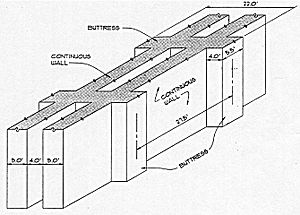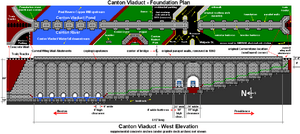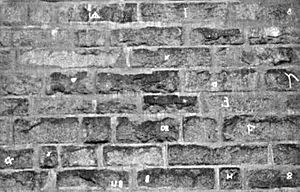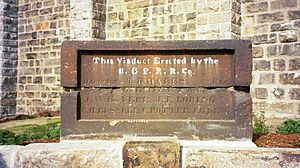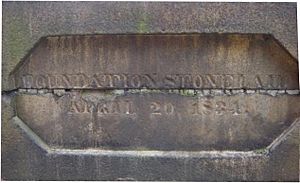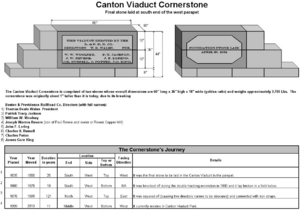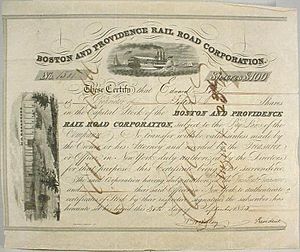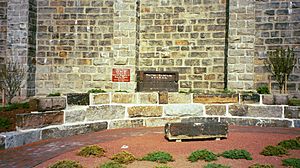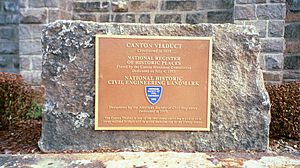Canton Viaduct facts for kids
Quick facts for kids Canton Viaduct |
|
|---|---|
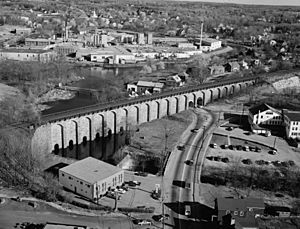
A west side view of the Canton Viaduct looking south with the former Paul Revere Copper Rolling Mill in the background, April 1977
|
|
| Coordinates | 42°09′32″N 71°09′14″W / 42.15889°N 71.15389°W |
| Carries | 2 tracks (standard gauge) presently serving: |
| Crosses |
|
| Locale | Canton, Massachusetts |
| Other name(s) | Great Stone Bridge, Viaduct at Canton |
| Owner | Massachusetts Bay Transportation Authority (MBTA) |
| Maintained by | Amtrak |
| Heritage status |
|
| Characteristics | |
| Design | Blind arcade cavity wall |
| Material |
|
| Total length | 615' |
| Width | 26'-28' (foundations), 22'-24' walls |
| Height | 60' above river level, 70' maximum height |
| Longest span | 2 at 28' (granite/concrete deck arches over the granite roadway portal) |
| Number of spans | 71 total |
| Piers in water | 7 (15 on land) |
| Clearance above | Approximately 21' |
| History | |
| Designer | William Gibbs McNeill, Chief Engineer for the Boston & Providence Railroad (B&P) |
| Construction begin | April 20, 1834 |
| Opened | July 28, 1835 |
| Statistics | |
| Daily traffic | 106 trains per day |
|
Canton Viaduct
|
|
| Location | Neponset and Walpole Sts., Canton, Massachusetts |
| Built | 1834 |
| Architect | McNeill, William Gibbs; Dodd & Baldwin |
| NRHP reference No. | 84002870 |
| Added to NRHP | September 20, 1984 |
The Canton Viaduct is a super old and super strong bridge in Canton, Massachusetts. It was built way back in 1834–35 for the Boston and Providence Railroad. This amazing structure is a type of bridge called a blind arcade cavity wall.
When it was finished, the Canton Viaduct was the longest (about 187 meters) and tallest (about 21 meters) railroad bridge in the whole world! Today, it's the only one of its kind still standing. It has been used continuously for over 190 years. Now, it carries fast passenger and freight trains every day. The train tracks are about 20 meters above the Canton River.
The Canton Viaduct was the last part needed to complete the 66-kilometer main railway line between Boston, Massachusetts, and Providence, Rhode Island. Today, it's a key part of Amtrak's Northeast Corridor. It also serves Massachusetts Bay Transportation Authority (MBTA) Providence/Stoughton Line commuter trains.
Contents
How the Bridge Started
The Boston and Providence Railroad built the Canton Viaduct in 1835. This happened soon after the railroad company began in 1831. William Gibbs McNeill, a Captain in the U.S. Army Corps of Engineers, designed the bridge. He was a graduate of West Point.
Other engineers helped him, including George Washington Whistler. Interestingly, Russia was very interested in building railroads at this time. The Russian leader, Tsar Nicholas I, sent workers to draw detailed plans of the Canton Viaduct. Later, he asked Whistler to come to Russia. Whistler helped design the Moscow–Saint Petersburg Railway, which included two bridges inspired by the Canton Viaduct.
How the Bridge Was Designed and Built
A Unique Design
The Canton Viaduct is special because it's the only known bridge that uses blind arcades with a cavity wall. This means it's a hollow bridge! Even though some parts look like they go all the way through, they don't. Only six river openings and two road openings actually pass through the entire bridge.
What Materials Were Used?
The Canton Viaduct was built with a lot of granite. Before its concrete deck was replaced in 1993, it weighed about 30,000 tons! Each stone has a special mark from the mason (stone cutter) who shaped it. The granite came from a quarry in Sharon, Massachusetts, which is now part of Borderland State Park.
Where is the Bridge Located?
Most of the viaduct (71%) is over land, and 29% is over water. It's about 187 meters long and has a slight curve. This curve makes one side of the bridge a little shorter than the other. At first, people called it "the great stone bridge" or "the viaduct at Canton." Later, it was named after the town. The very first stone was placed on April 20, 1834, in a special ceremony.
Building the Bridge
The Canton Viaduct cost $93,000 to build. That would be like millions of dollars today! It took 15 months and 8 days to finish, from April 20, 1834, to July 28, 1835.
The bridge was built before safety equipment like hard hats existed. Amazingly, no one died during its construction! However, some people have died crossing the bridge since it was built, usually when trains passed in opposite directions. The first "passenger" to cross the finished bridge was an old white horse named Charlie. He was placed on a flat car and pulled across by the workers.
The Providence Journal newspaper described the viaduct in June 1835. The first train engine to travel the entire length of the railway, including the new bridge, was named "Whistler."
The Dedication Stone
The Dedication Stone was the very last stone placed in the viaduct. It's actually two stones joined together. It weighs about 1,700 kilograms! The stone was damaged in 1860, which made it a little shorter and hid the names of two important directors.
Old Railroad Tracks
During a renovation in 1993, workers found two deep grooves in the granite deck stones. These grooves ran the entire length of the bridge. They held special wooden beams called "baulks." These baulks supported the rails. This was a unique way to build tracks back then.
Who Owned the Bridge?
- 1834–1888: Boston & Providence Railroad Corp.
- 1888–1893: Old Colony Railroad Co.
- 1893–1969: New York, New Haven and Hartford Railroad Co.
- 1969–1973: Penn Central Transportation Company
- 1973–present: Massachusetts Bay Transportation Authority (MBTA)
A Very Important Bridge
The Canton Viaduct has been considered a critical part of the country's transportation system for a long time.
- World War I: Soldiers guarded the viaduct in April 1917 to protect it from attacks.
- World War II: Local defense groups and railroad workers also guarded the bridge. It was a direct link between Boston and New York City, so it needed extra protection.
- War on Terrorism: After the September 11, 2001, attacks, the Canton Viaduct was guarded again. This was because it's a high-risk target that could disrupt the national railroad system.
Awards and Recognition
- The Canton Viaduct was added to the National Register of Historic Places in 1984. This means it's recognized as an important historical site.
- In 1998, the American Society of Civil Engineers named it a National Historic Civil Engineering Landmark. This award honors important engineering achievements.
Current Status
In June 2004, the town of Canton created a plan to preserve and improve its important places, including the viaduct.
Images for kids
See Also
- National Register of Historic Places listings in Norfolk County, Massachusetts
- List of bridges documented by the Historic American Engineering Record in Massachusetts
- List of bridges on the National Register of Historic Places in Massachusetts


